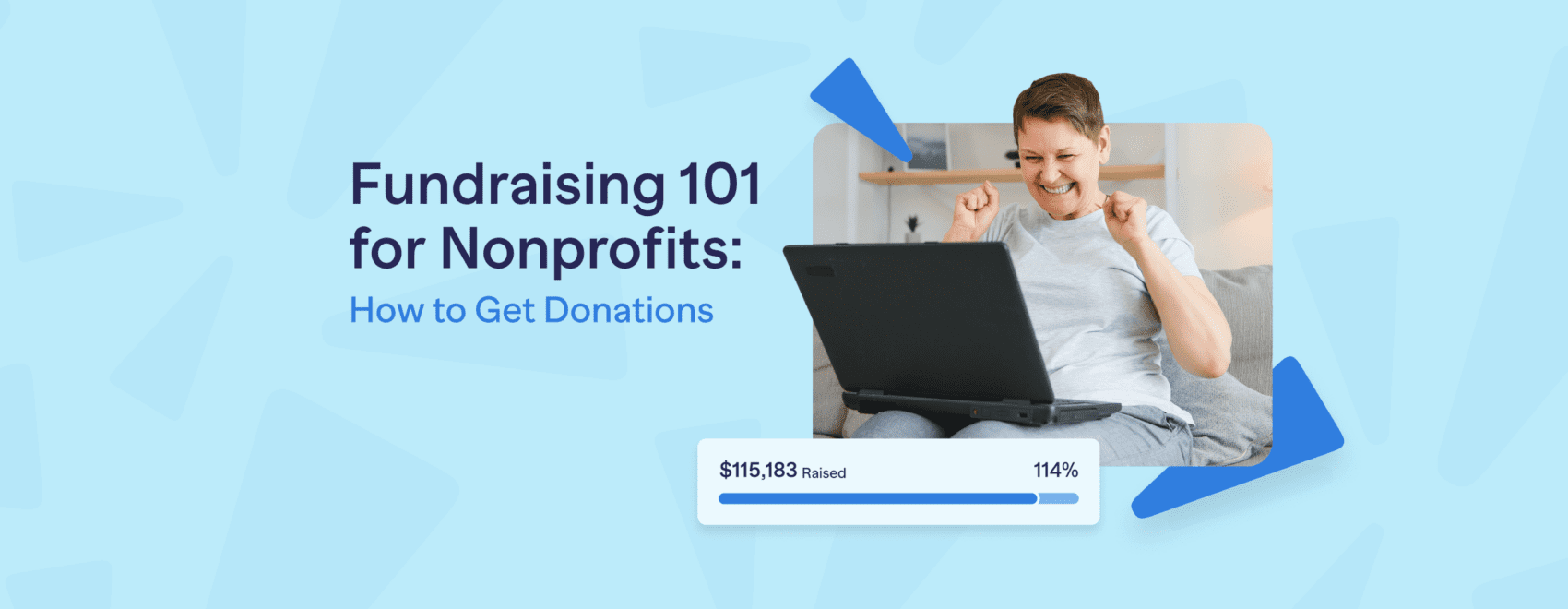In this article
- The Importance of Fundraising for Nonprofits
- Different Types of Fundraising Campaigns
- How Nonprofits Create an Effective Fundraising Strategy
- The Role That Donors and Supporters Play in Your Nonprofit Fundraiser
- Effective Techniques for Nonprofit Fundraising
- Technology for Nonprofit Fundraising
- Nonprofit Fundraising Demystified: Fundraiser, Appeals, and Funds
- How to Write a Fundraising Ask That Actually Gets a YES
- How to Measure Fundraiser Success
- Compliance and Ethical Considerations in Nonprofit Fundraising
Over the last decade, I’ve had the chance to work with organizations of all sizes and with some amazing nonprofits, learning the ins and outs of fundraising along the way. It’s not always easy, experiencing everything from grassroots campaigns to large-scale fundraising strategies, but it’s incredibly rewarding when everything clicks. Whether it’s building the campaign or simply figuring out how to make “the ask” without feeling awkward, I’ve seen (and made) plenty of mistakes—and found solutions for every problem I encountered.
In this article, I’m sharing some of those tried-and-true fundraising 101 tips. I’ll guide you through the essentials of nonprofit fundraising, from writing a compelling ask to leveraging technology and donor relationships. Think of it as a guide for helping you keep the focus. If you’ve ever wondered where to start or how to level up, you’re in the right place. Over the years, I’ve seen so many misconceptions about fundraising, and I think clearing these up can make a huge difference in how nonprofits approach their work. Let me share a few I’ve come across:
Fundraising is Just Asking for Money.
It’s easy to think this, but no—fundraising is so much more. It’s about building relationships, originating stories that move people, and sparking a real emotional connection to your mission. It’s not just a transaction.
Once a Donor Gives, They’ll Keep Giving.
Oh, I wish it were that simple! Keeping donors engaged is all about showing them love. Say thank you, let them know what their gift accomplished, and keep them in the loop with updates. Without that, they might feel forgotten and move on.
Anyone Can Fundraise.
Sure, anyone can try to fundraise, but doing it well takes skill. You need to know how to communicate, market your cause, and manage relationships. Passion is the beginning, but strategy is what gets results.
If the Cause is Good Enough, People Will Donate.
An impressive cause isn’t always enough. People need to trust that their money will make an impact. That means showing transparency, accountability, and the real difference their donation is making.
And so on, and so on…
The Importance of Fundraising for Nonprofits
Think of Fundraising 101 for nonprofits as your first step toward friendraising, building connections, relationships, and opportunities that turn vision into impact. If the thought of donor cultivation or tackling the overhead myth feels daunting, don’t sweat it. We’ll help you unravel the basics of Fundraising 101, one step at a time. You don’t have to figure it out alone.
We all love that warm, fuzzy feeling when we do something good for someone else, don’t we? That’s exactly what fundraising is about—it’s giving people the chance to feel that joy by supporting a cause they believe in.
And you know what else? People are often thrilled to give as long as they can see how their donation will make an impact. It’s your job to show them, inspire them, and invite them to join in. That’s the energy behind Nonprofit Fundraising 101—connecting the right people with the right message at just the right time.
Did you know that in 2023, charitable giving in the United States reached approximately $557.16 billion, with individual donors contributing about $374.40 billion, representing 67% of the total?
You’ll find out that fundraising is the journey from “can’t” to “can.” At its core, it’s about connecting people with purpose and inviting them to be part of something bigger than themselves.
Providing funds opens the door; empowering communities keeps it open. You’re about to embark on an incredible donor journey. (It’s the process a donor goes through, from their first interaction to becoming a loyal supporter or major donor).Fundraising isn’t magic, and you don’t need to be a born expert—it’s a skill, and we’re going to help you master it.
Sound exciting?
Let’s see what the basics of fundraising 101 for nonprofits are.
What Makes Fundraising Work?
Fundraising 101 is about building trust and creating opportunities for people to say, “I want to be part of this!” Here are the must-haves of any worthwhile fundraising effort:
- Crystal-Clear Goals: Start with a destination in mind. Whether it’s raising $10,000 or launching a community project, knowing your “WHY” will guide every step of fundraising for nonprofits. A clear target keeps everyone focused.
- Know Your Audience: Fundraising isn’t one-size-fits-all. Who’s most likely to support your cause? Is it individuals passionate about your mission, local businesses, or major organizations? The right audience can turn “MAYBE” into “YES!”
- Tell a True and Impactful Story: Facts tell, but stories sell. Share the “why” behind your cause. A powerful story builds an emotional bridge between your mission and their generosity.
When these elements come together, compassion meets commitment. Not just donations, but a ripple effect of awareness, support, and lasting connections starts happening.
Let’s demystify fundraising for nonprofits and focus on making a real impact by exploring every piece of it.
Different Types of Fundraising Campaigns
Some tried-and-true methods that work best and that nonprofits love:
- Personal Appeals: Send heartfelt letters, postcards, or even a friendly text directly to potential donors. Personal touches go a long way and stand out.
- Online Campaigns: Use social media, email blasts, or crowdfunding platforms like RallyUp to spread your message far and wide. A few clicks can reach thousands.
- Community Events: Host a fundraiser that doubles as an Event. Think gala dinners, fun runs, charity walks, or even virtual trivia nights.
You don’t have to pick just one! Mix and match strategies to reach your audience where they’re most engaged.
Each method has its perks. Direct appeals are PERSONAL. Online campaigns are FAST. Events build COMMUNITY. Pick the one that fits your cause best—and go for it! Fun and funds, all in one!But here’s the secret: successful fundraising isn’t just about the ask—it’s about the CONNECTION. Share your mission with passion. And always, always keep the focus on impact. Your enthusiasm can inspire incredible generosity!
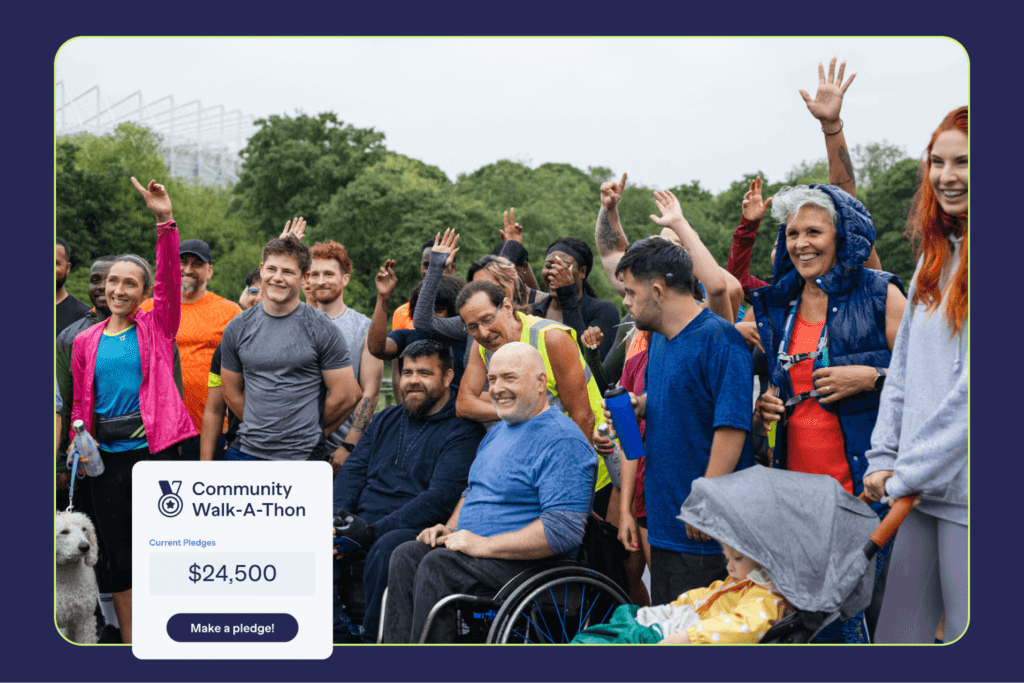
Your Perfect Fit!
Ready to make an impact? RallyUp has tons of exciting ways to do it!
1. Raffles
Want to add some excitement to your fundraiser? Raffles are all about fun and prizes. Supporters buy tickets, you draw a winner, and everyone’s hooked through the allure of winning.
Good for: Nonprofit who wants to energize their audience with appealing prizes and raise funds fast.
2. Auctions
Bidding wars = large sums! Let supporters bid on cool items or activities. The highest bid wins, and you win big for your cause. Live auctions or online auctions provide flexibility and broad reach.
Good for: Nonprofits with unique items or activities to offer. Great for raising significant funds fast!
3. Sweepstakes
Participants enter a draw, often without a purchase requirement, for a chance to win prizes! Sweepstakes open the door for everyone to join in, making it super inclusive and engaging.
Good for: Reaching a wide audience, encouraging widespread participation, and expanding donor participation.
4. Events & Ticketing
Hosting a fundraising event? From ticket sales to registrations and donations. You focus on the fun; we handle the logistics.
Good for: Galas, concerts, workshops, or any event that brings people together for your cause.
5. Crowdfunding
Share your story. Inspire your community. Watch the donations roll in from a large audience. Crowdfunding makes it easy to rally support online by social sharing.
Good for: Mobilizing communities to come together for a shared goal through storytelling.
6. A-Thons
Walk, run, read, or dance! A-Thons are all about action (e.g., walkathons). Participants collect pledges and join the activities, all while raising money.
Good for: Active communities that love getting involved in physical events in a hands-on way.
7. Store (Sales)
Sell it, fund it, love it. Open an online store and sell branded merch or products to support your cause.
Good for: Organizations looking to add a creative revenue stream and build a nonprofit’s brand visibility.
8. Livestreaming
Go live, raise funds, and connect with your audience in real-time. Livestreaming integrates live video events with fundraising activities.
Good for: Nonprofits aiming to host virtual events, interact live with supporters, and reach a global audience with energy and personality.
9. Donation Pages
Make giving simple. Custom donation pages let organizations collect one-time or recurring donations.
Good for: Organizations seeking a straightforward method for donors to contribute online.
What Is Peer-to-Peer Fundraising?
Peer-to-peer (P2P) fundraising is one of the most versatile fundraising strategies, and it blends with other types of campaigns to maximize your reach. By combining P2P with other fundraising methods, you tap into the strengths of each approach while empowering your supporters to take the lead.
Instead of relying solely on your organization to spread the word, your supporters create personal fundraising pages and share them with their friends, family, and networks. It’s like multiplying your fundraising power overnight!
- Why It’s Powerful:
Peer-to-peer fundraising expands your reach and builds awareness. It’s fundraising and friend-raising all in one. - Good for:
Any campaign where supporters are excited to rally their networks.
For example:
Peer-to-Peer + Raffles
P2P fundraising energizes Raffles by turning supporters into ticket-sellers who bring their networks into the mix.
- How It Works:
Each supporter’s P2P page includes the option to purchase raffle tickets. The more they promote their pages, the higher the Raffle sales—and the bigger the pool for your cause. - Example: A school fundraiser lets students sell Raffle tickets through their personalized P2P pages to win a grand prize.
- Why It Works:
The Raffle incentivizes supporters to share their pages widely, boosting participation and funds.
10. Multiple Fundraising Activities with RallyUp
Why choose one method when you can create a multi-activity fundraiser for maximum impact?
RallyUp lets you MIX AND MATCH fundraising styles to suit various campaign goals and different audiences. You can run multiple activities at once in a single fundraiser. You can combine, let’s say, a Raffle, Crowdfunding, and a Store in one campaign. You can even run both a prize Raffle and a 50/50 Raffle together.
How Nonprofits Create an Effective Fundraising Strategy
Successful nonprofit fundraising doesn’t just happen—it’s built with purpose. It’s not about tossing out cold calls and hoping for the best. Winning fundraising is all about strategy. A well-made plan balances your nonprofit’s goals with your donor’s passions and interests.
Plus, planning ahead is pivotal to avoid a funding cliff (a sudden loss of major grants or donors), which could threaten your sustainability. Diversifying income streams is a smart strategy to mitigate this risk.
That said, successful fundraising is a mix of heart and strategy—and it all starts with a strong foundation, as you are discovering in Fundraising 101 for nonprofits.

Lay the Groundwork with Fundraising 101 principles
Spectacular fundraising for nonprofits isn’t accidental—it’s a combination of planning, passion, and persistence.
Set your sights high, but start with the basics:
- Define Clear Goals
First things first: know what you’re aiming for. Be really specific. What are you aiming to achieve? A dollar amount? A specific project? Clear goals keep your team and donors focused. Now, you can explain exactly what you need, why it matters, and how donations will make an impact. Transparency builds trust, and trust makes donors feel confident about giving.
- Sharpen Your Nonprofit’s Brand
Think branding is just for businesses? Think again. Your nonprofit’s brand is how you communicate your identity and mission. It’s what sets you apart and shows donors who you are and why your work matters.
Your nonprofit’s story matters. What do you stand for? Why should people care? Build a brand or nonprofit’s story that inspires trust and passion.
Your brand is more than a logo or tagline—It’s about being consistent in how you present your mission across emails, social media, and events. When donors see a post or an appeal, they should immediately recognize it’s from you.
Consistent branding builds trust. It shows donors you’re organized, professional, and deeply committed to your cause. And trust? That’s the foundation of long-term support.
- Know Your Donors: Who’s most likely to support your cause? Individuals? Corporations?
Are you trying to appeal to everyone, or do you know exactly who your ideal donor is? Spoiler alert: not everyone is going to connect with your mission—and that’s fine! The secret to successful nonprofit fundraising 101 is focusing your energy on THOSE WHO ARE MOST LIKELY TO CARE.
Think about it. If you’re running a pet rescue, you wouldn’t target someone who dislikes animals. But an animal lover? That’s your person!
Similarly, someone who’s personally impacted by your cause—whether it’s education, health, or the environment—is far more likely to support your nonprofit than someone with no connection.
Start by asking: Who is most likely to care about my mission? Look at key factors like:
- Interests: What do they care about?
- Demographics: Age, income, and location matter so your efforts hit the mark.
- Connection: Has your cause touched them in some way? Does your mission resonate with their personal experiences?
Already have donors? Perfect! Dive into the data. Look for patterns in age, income, or shared values. Starting fresh? Research similar nonprofits to see who supports them. You’re not copying their audience or taking their donors—you’re learning from their success and applying it to your community.
Focusing on the right people means less wasted effort and more meaningful connections.
Fundraising without a plan? Nope, not gonna work. You need a clear plan to make things happen.
Think about the fact that micro donors ($1−$100) account for over half of all donors. Consider that the donor retention rate decreased in Q2 2024, continuing a trend from previous quarters. When you are aware of numbers and take into account challenges in maintaining donor engagement, you’ll know how to make an informed decision.
For example, let’s get started with a simple game plan—your Fundraising 101 Calendar. Don’t worry, it doesn’t have to be perfect. You’ll tweak it as you go.
Start with what you know. Got events lined up? Mark those down. Planning The Color Run, Bike MS, Relay for Life, or a Do-Good December, World Giving Day, #DoGoodWeek? Write those in! Take it month by month. Decide when to ask for donations, when to share your most inspiring stories, and when to invite people to join the action.
Timing is everything. Keep in mind that approximately 30% of annual giving occurs in December, with 10% happening in the last three days of the year. The significance of year-end fundraising efforts is obvious.
Seriously, don’t overload yourself (or your donors!) with constant fundraisers. Nobody likes burnout, and you’ll want to keep your energy high. Balance is key—mix in non-ask activities. Host a thank-you event, share cool behind-the-scenes updates, or spotlight your volunteers. It keeps donors engaged without wearing them out.
Here’s the truth: Fundraising is like climbing a mountain; each step forward may be slow, but persistence leads to reaching the summit.
You’ll always be searching for new donors, sharing your mission, and finding fresh ways to say “thanks.” It takes time, but the more you build relationships, the more your momentum grows. And when you’ve got momentum? Oh, everything gets easier.
Now, let’s talk about how to grow that base into a support powerhouse!
The Role That Donors and Supporters Play in Your Nonprofit Fundraiser
Donors and supporters are the heroes of nonprofit fundraising. They bring the energy, the resources, and the soul of essence that make everything possible.
Financial Contributions
Donations power the mission. Every dollar helps turn plans into actions, funding programs, operations, and life-changing initiatives. RallyUp offers free Donation Pages to help with fundraising all year. It also converts supporters into regular donors.
Ambassadors and Advocacy
Supporters are megaphones for the cause. They spread the word, share the message, inspire others, and grow the movement by increasing its visibility within the community. Engaging tools like Peer-to-Peer fundraising allow supporters to create their own pages, expanding the organization’s reach and impact.
Volunteerism
It’s more than money. Beyond financial support, many donors contribute their time and skills, assisting in events, campaigns, and daily operations. RallyUp’s Events & Ticketing feature simplifies organizing and managing events, making it easier for volunteers to contribute.
Feedback and Engagement
Supporters don’t just give—they guide. Their ideas and feedback help nonprofits stay sharp and focused on what matters most. With Donor Profiles, organizations can get to know donors as friends, enabling personalized communication and stronger relationships. This can help avoid nonprofit burnout among staff and volunteers. Building strong donor relationships could alleviate some of the stress caused by limited resources and constant pressure to fundraise.
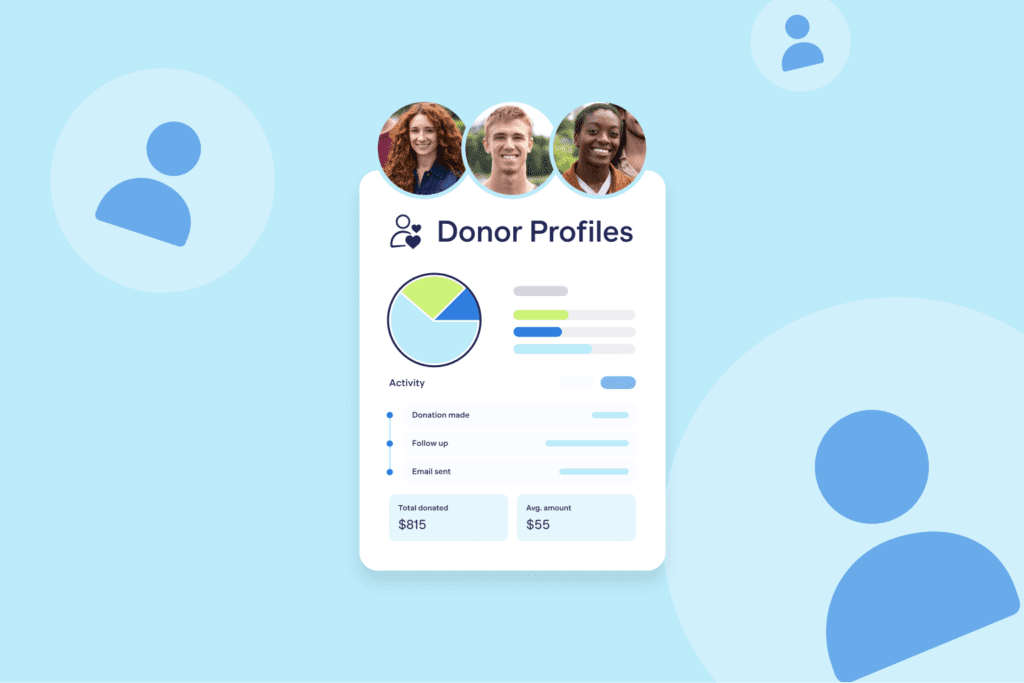
Growing Your Donor Base
Your nonprofit’s success depends on the strength of your donor base. But how do you grow it? Are you trying to build one by adding names to a list? Well, it’s all about reaching the right people and building genuine connections. A strong donor is a community of supporters who believe in your mission and want to see you succeed.
Here’s the deal: you don’t build lasting relationships with donors by just cranking out fundraiser after fundraiser. Nope, that’s not how it works.
You build those connections by inspiring them. Show them the incredible work your organization is doing. Thank them every single time they give—and even when they don’t. Keep them in the loop, always.
Treat your donors like the philanthropic, caring, and generous people they are. When you honor that, they will respond favorably and positively. Sometimes, they’ll give way more than you ever imagined.
In donor-focused fundraising, it’s simple: the donor matters more than the donation. Always.
- Building Your Prospect List
An outstanding donor base starts with a smart prospect list. It’s not about reaching everyone; it’s about reaching the rightones. For small nonprofits, this can be a lifesaver.
Since you’ve already defined your ideal donor, it’s time to use that knowledge to create a focused list of potential supporters. For small nonprofits with limited time and resources, a well-targeted list can be a game-changer. Quality over quantity is the name of the game!
- Building a Donor Persona
The secret to an effective prospect list? A clear picture of your ideal donor. That’s where a donor persona comes in.
A donor persona is a fictional but detailed representation of your ideal supporter. Think of it as a profile of the person most likely to care about your mission. Think about details like:
- Age, location, and income
- Hobbies, values, and interests
- Personal connection to your mission
Here’s the secret: it’s not about how much money people have. It’s about how much they care about your cause. That’s who you’re looking for—people who get it.
So, who are they? Are they younger or older? Men or women? What are their passions? Do they care about food insecurity, animal rescue, youth programs, or something else you tackle?
Think back to the first few people who said, “Yes, I’ll donate!” Picture them. Write down their names. Now, jot down everything you know about them. What do they do for work? Did they go to college? Are they part of a church? Do they love running or cheering at kids’ soccer games?
Look for the patterns. Are they the same age? Gender? Do they share similar values? Live nearby? Anything they have in common can point you in the right direction.
When you know who cares, you know who to connect with. And that’s how you find your people!
Let’s say your nonprofit focuses on youth education. Your donor persona might be a middle-aged parent who values educational equity and wants to make a difference in children’s lives.
Back when I first started in fundraising, I had this “aha” moment that totally changed the game for me. I was thinking about our best donors and thought, “What if I really dig into who they are?” So, I did. And here’s what I found:
- They loved supporting kids’ programs.
- They were mostly moms in their 30s and 40s.
- They were super involved in their local PTA.
- They cared deeply about community projects.
- Oh, and they were all about sports fundraisers.
When I looked at that list, BAM—lightbulb moment! I realized I didn’t need to wait for donors to find us. I needed to show up where they were: PTA meetings, soccer fields, and community bake sales.
Turns out, meeting people where they’re passionate is a game-changer. You connect. They care. And suddenly, you’ve got a group of donors who get your mission and want to make it happen with you.
A strong donor persona helps you FOCUS your outreach, refine your messaging, and connect with the people who are most likely to support your mission.
Ready to put it all together?
- Finding Potential Donors
Once you’ve nailed down your target audience, it’s time to connect with potential donors. Start where it’s easiest—your personal network. Reach out to friends, family, colleagues, and anyone who might be interested or know someone who is. People want to help, and sometimes all it takes is asking.
Don’t forget about the power of social media. The platform you choose matters. If your mission appeals to Gen Z, TikTok and Instagram might be your goldmine. But if you’re aiming for middle-aged professionals, LinkedIn or Facebook could be a better bet. Meet your donors where they already are.
Social media: Look for people engaging with similar causes. Follow hashtags, join groups, and build connections.
Email Lists: Got a list of subscribers from events or newsletters? Reach out! These are warm contacts who’ve already shown interest in your nonprofit.
Engage with your community: Team up with local businesses or other nonprofits in your area. A small business might want to sponsor an event, or another nonprofit might collaborate with you to amplify impact.
Fundraising Channels
Fundraising is all about connection. It’s about meeting your supporters where they are and giving them an easy way to be part of your mission. Every channel you use is a chance to share your story and invite people to make a difference.
Each channel has its strengths, and the key is finding what works best for your nonprofit. A mix of methods can help you reach more people and engage your community.
Let’s explore the options and how they can work for you.
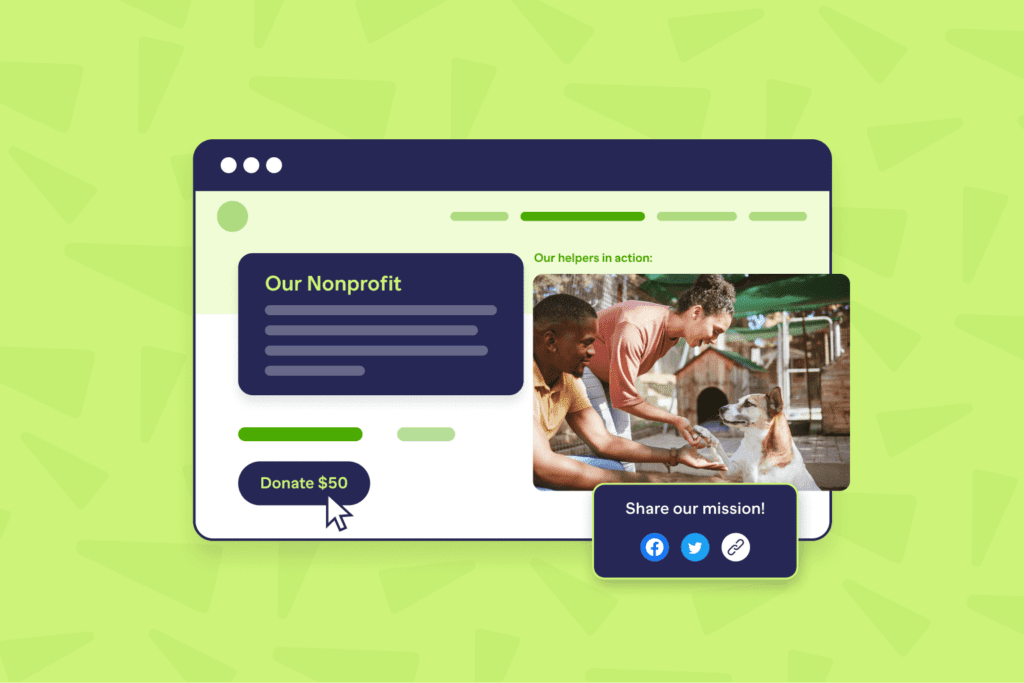
Your Nonprofit Website
Your website is a home base. It’s where donors, volunteers, and curious supporters come to learn about you. First impressions matter, and your homepage is the digital handshake that welcomes them.
Here’s how to make it welcoming:
- Keep It Fresh: Make sure the content is up-to-date. Visitors should know your nonprofit is active and making an impact.
- Tell Your Story: Use visuals and concise text to share your mission and why it matters.
- Make It Easy to Give: Embed a donation form right on your homepage. Don’t make people search for how to help—they should see it at a glance.
Even with a small budget, investing in a strong homepage can make a huge difference. It’s your digital first impression, so make it count!
Why Combine Multiple Channels?
Not everyone connects in the same way. Some people might find you through your website, Some prefer the personal touch of direct mail, while others see your mission on social media and others love the convenience of online giving.
By using multiple channels—like email, social media, and events—you can meet supporters where they’re most comfortable.
Here’s a tip: Don’t spread yourself too thin. Focus on a few key platforms that resonate with your audience, then expand as your resources allow.
Connection Comes First
Think of your fundraising channels as tools in a toolbox. Your website is the foundation, but layering in other channels—like social media, email campaigns, or events—can help you build something amazing.
Start with your website. Share your story. Make it easy for people to help. And remember—it’s not about being everywhere. It’s about creating moments that matter.
Emails are a fantastic way to connect with your supporters. They let you share stories, updates, and photos while keeping things personal and direct. Let’s say you want to rekindle the passion of lapsed donors. Reach out personally and update them on the projects they’ve helped before, bringing their enthusiasm back to our cause.
Why Emails Work
They’re personal. They’re direct. They’re a chance to keep your supporters in the loop.
- Tell Stories: Use them to share the impact of your work. Paint a picture of the difference donors are making.
- Share Updates: Monthly or quarterly emails let supporters know how things are going. Short on time? No problem! Keep it brief and add a couple of action-packed photos.
Track and Improve
Emails are also a way to learn about your audience.
- Track Engagement: Monitor open and click-through rates to see what resonates.
- Adjust Your Approach: Use this data to make your emails even more engaging and impactful.
Targeted, But Limited
One of the best things about email? It’s targeted.
- Custom Messages: You can tailor emails for specific groups, like thanking major donors or reconnecting with lapsed supporters.
- Personalization: Address recipients by name and align your messaging with their giving history or interests. Show that you see donors as individuals, not just part of a list.
The downside? Emails often have limited reach.
- Inbox Overload: With inboxes overflowing, your email might get lost in the crowd.
- Limited Reach: Unlike social media, emails don’t spread organically. It’s a one-on-one connection, so your message won’t go far beyond the recipient.
So, next time you hit send, remember: your email is more than a message. It’s a moment to inspire, connect, and remind your donors why they’re part of something incredible.
Text Messages: Quick, Direct, and Powerful
Texting your donors is like reaching out to a friend. It’s quick, it’s personal, and it works. In fact, 88% of people use their mobile phones primarily for texting, text messages boast a 98% open rate, and 60% of recipients reply within 1-2 minutes on average.
Why Texts Work
Texts are short, sweet, and straight to the point. They are high-engagement tools for both professional and personal purposes. They let you:
- Reach Donors Fast: People read texts almost instantly, making it one of the fastest ways to connect.
- Be Direct: Say what you need in as few words as possible.
- Add a Link: Want to share more? Include a link to a page with your full story or donation form.
- Make a Personal Touch: Even a mass text can feel personal when done right. Address the recipient by name when possible—it is way more impactful.
With the right tools, you can send personalized messages to hundreds of donors without losing that human touch.
The Downsides
Texts are great for quick outreach, but they have their limits.
- No Long Stories: You can’t dive deep into impact or tell a detailed story, but you can spark curiosity.
- Respect Their Space: Don’t overdo it. Too many texts can feel intrusive, so use them sparingly.
Why You Should Try It
Text messages let you connect fast, share important updates, and make donors feel special—all without taking up too much of your or their time.They’re not a replacement for emails or calls, but done with care, texts can be a powerful addition to your outreach.
Social Media
Social media is your nonprofit’s compass for global impact. It’s where you can keep supporters updated and reach a broader audience—all while showing the heart of your mission.
Why Social Media Works
People want to feel inspired. They want to see the impact, and social media gives you the perfect stage to show it.
Also, people love visuals and quick updates. And that’s where social media shines.
- Catch Attention Fast: Use photos, videos, or graphics to tell your story in seconds.
- Reach More People: Posts have the potential to go beyond your donor list and find new supporters.
- Stay Relevant: Regular updates keep your nonprofit at the top of mind.
Social media is perfect for sharing the impact of your work in ways that inspire and engage.
The Pros and Cons
Social media has big advantages:
- Broad Reach: Your posts can be seen by people outside your usual audience.
- Visual Storytelling: Let images and videos do the talking.
- Ongoing Engagement: It’s a chance to connect with your followers regularly.
But there are trade-offs:
- Less Personal: Social media isn’t as tailored as emails or texts.
- General Messaging: Posts need to appeal to a wide audience, not specific donor groups.
- Time Commitment: To stay visible, you’ll need to post often and keep up with trends.
Find the Right Platforms
You don’t need to be everywhere. And not all platforms are created equal. Think about where your supporters spend their time:
- Instagram: Perfect for photos and short videos. Great for younger audiences.
- Facebook: A go-to for community building and event promotion.
- LinkedIn: Ideal for professional networking and corporate donors.
- TikTok: A chance to connect with younger audiences through creative, bite-sized videos.
Focus on the platforms where your donors are most active, and don’t spread yourself too thin.
Make It Count
Social media is a powerful tool to share your story, celebrate wins, and engage with your community. Use it to create a buzz around your mission, but keep your posts authentic and visually compelling.
Direct Mail and Phone Calls
Don’t underestimate the power of traditional methods, even in the digital age. There’s something special about receiving a letter. It’s personal and tangible and connects with donors who prefer something more personal than email.
If you want to make it personal, pick up the phone. There’s no better way to connect with long-time givers than a real conversation. It’s perfect for connecting with your biggest supporters and major donors. These unicorn donors who make large, unrestricted gifts can inspire nonprofits to aim to cultivate such relationships.
At the end of the day, when you invest in thoughtful outreach, whatever it is, the results are always worth it!
One Size Doesn’t Fit All
Diversifying your communication channels builds stronger relationships. It shows your audience you care about how they want to connect. And that’s the foundation for long-term support.
Your supporters are individuals with different habits and preferences. So, tailoring your outreach is as thoughtful as it is effective. When people feel heard, they’re more likely to engage.
That’s why understanding and respecting your audience’s preferences is key.
When you use a mix of channels, you expand your reach and make your communication more meaningful.
Build Mutual Relationships
Here’s a tip: Donor relationships are a two-way street. It’s easy to focus on what you need, but don’t forget to think about what others might gain by partnering with your nonprofit.
Engage with your community. Relationships built on trust and mutual benefit are the ones that last. The more you give back, the more people will want to join your mission.
Keeping the prospect list organized and up-to-date ensures your efforts stay on track. Many new nonprofits start with spreadsheets. If you’re going this route, make sure your system is simple, clear, and easy to update.
But here’s the catch: spreadsheets are great for getting started but can quickly become overwhelming. They can only take you so far. They’re great for storing data but not for turning that data into action. When was the last time a spreadsheet reminded you to follow up with a donor or helped you craft a personalized thank-you email?
Need help?

Effective Techniques for Nonprofit Fundraising
Consider a Nonprofit CRM
CRM (Customer or Constituent Relationship Management) is like having an extra team member dedicated to organizing, tracking, and improving your donor relationships.
Managing your donor list shouldn’t feel like a chore. Whether you’re just starting out with spreadsheets or ready for CRM, the key is keeping your data clean, accessible, and actionable. The better you manage your donor relationships, the more connected and supported your nonprofit will be.
CRM will:
- Organize Data: Keep all donor information in one place—no more juggling spreadsheets.
- Track Interactions: See who donated, when, and why. Never lose track of donor history.
- Automate Outreach: Use built-in tools to automate emails, reminders, and updates to keep donors engaged and valued.
Platforms like RallyUp go beyond just tracking donations. They combine donor management, online giving, and communication tools to make fundraising all in one easy-to-use system.
What can a great CRM do for your organization?
RallyUp makes managing your fundraising and donor relationships simple, effective, and—dare we say it—fun!
- Donor Management
Easily keep track of all your donors. RallyUp’s Donor Profiles show every donation, message, and interaction, so you can really get to know your supporters. Building relationships? Check. - Contact Management
It’s not just about donors! RallyUp lets you organize info on volunteers, members, and stakeholders too. Everything’s in one place, easy to find, and ready when you need it. - Fundraising Tools
With 10 Ways to Raise, you can run Raffles, Auctions, Crowdfunding fundraisers, and more—all in one platform. Plus, donation tracking is built right in. Talk about making life easier!
Use lots of tools to manage your nonprofit? No problem! RallyUp works with Zapier to connect your fundraising to over 5,000 popular apps. Imagine automating almost anything—comfortably.
With RallyUp, everything just works.
- Donor Outreach
Stay in touch with your supporters. RallyUp integrates with email tools to help you send personalized messages and updates. Tailored outreach? Done and done.
Need better email campaigns? RallyUp integrates with MailChimp, ActiveCampaign, SendGrid, and more. Build smart, personalized outreach that wows your donors and keeps them coming back.
- Volunteer Management
Need help organizing volunteers? While RallyUp focuses on donors, it’s also great for keeping basic volunteer info handy. - Reporting and Analytics
Want to know what’s working? RallyUp’s reporting tools give you clear insights into your campaigns and donors. Make smarter decisions without breaking a sweat. - Integration with Other Tools
Already using tools like Salesforce, HubSpot, or Mailchimp? No problem. RallyUp integrates seamlessly, so everything works together smoothly.
- Security and Compliance
Your data is safe with RallyUp. We take privacy seriously and follow top industry standards to keep everything secure.
To put it simply – level up your nonprofit game.
Build Real Relationships with Your Donors
Fundraising is about people.
Think about this: If the only time someone reached out to you was when they needed something, how would that feel? The same goes for donors. They don’t just want to be funders—they want to be part of the story.
You might think, “I’m swamped! How can I personally connect with every donor?” While it’s challenging to know everyone, taking time to personally engage with major donors or consistent supporters can make someone feel valued.When donors feel seen and valued, they’ll want to stick with you.
Even small gestures go a long way. A quick note, email, or text shows you care beyond their donations. A good CRM will do that for you.
For your major donors or long-time supporters, take time to really connect. Meet for coffee, hop on a Zoom call, or simply ask how they’re doing. It’s not about the size of their gift. It’s about showing that their involvement means something to you.
Celebrate Milestones
A simple way to stay connected is to recognize milestones. Did they make their first gift last year? Is it their birthday? These moments are opportunities to reach out with gratitude and kindness. A heartfelt message can make someone feel truly appreciated.
The good news? You don’t have to remember all these details on your own. A good donor platform with CRM can give you gentle reminders to help you stay on top of these special dates.
Appreciation Leads to Loyalty
When donors know they’re more than just a name in your database, they’re more likely to stay engaged. They’ll not only give but advocate for your mission. They’ll feel like they belong.
If you’re feeling overwhelmed by data and outreach, look for tools that simplify the process. The right donor development platform that acts like a virtual fundraising assistant can help you turn donor insights into meaningful actions.
At the end of the day, it’s about building a community, not just raising funds. Your donors believe in what you do—show them that their trust matters. Because when you make people feel valued, extraordinary things will be waiting to unfold.
Fundraising Outreach That Feels Like Connection
Outreach is not solely about updates—it’s actually about people. It’s letting your supporters know they matter and that their generosity makes a real difference. Regular updates are more than a task on your to-do list—they’re how you share the heart of your mission with the people who believe in it.
Why Updates Matter
Your donors don’t just want to give—they want to belong. They want to feel like they’re part of the journey, not just funding it.
When you share updates, you’re doing more than reporting numbers. You’re saying, “You’re with us in this. Look at what we’re achieving together.” It’s a way to celebrate the impact of their support while building a stronger connection.
But here’s the key: communication has to go beyond fundraising appeals.
Show, Don’t Just Ask
Constant fundraising appeals can wear donors out and can lead to donor fatigue. No one likes to feel like all they are good for is their money. But when you share stories—of lives changed, challenges overcome, dreams achieved—you remind them why they gave in the first place. When you keep supporters in the loop, they feel like true partners in your mission.
Here’s how you can keep the connection alive:
- Celebrate Success: Show them the smiles, the milestones, the progress. Let them feel the difference they’re making. Let donors see their generosity in action.
- Be Honest: Donors want to know the full story, not just the highlights. Share the struggles too. People want to help, they value transparency and want to feel like they are part of the solution.
- Say Thank You: A heartfelt thank-you note, quick thank-you video, or email isn’t just polite—it’s powerful.
Make It Personal
People connect with people.
Donors aren’t all the same, and your updates shouldn’t be either. Tailor your outreach. Take time to connect. Small gestures, when sincere, can leave a big impression.
Personalize your messages and outreach whenever possible—it shows you see them as individuals, not just names on a list.
When donors feel seen, heard, and appreciated, they don’t just stay—they become advocates. They’ll talk about your mission, share your stories, and bring others into your community.
Updates aren’t just about keeping people informed. They’re about reminding your supporters WHY they’re part of something extraordinary. And make sure they know just how much they mean to you. They’re the ones who stick around, give generously, and rally others to your cause. So, let’s make those connections matter.
Technology for Nonprofit Fundraising
Technology is changing the way nonprofits work, making fundraising smarter, faster, far-reaching and more engaging. Did you know that 64% of donors prefer to give online using credit or debit cards? Digital donation platforms make it easier for people to give to causes they care about.
RallyUp is a standout example of how technology with a suite of tools can transform the reach of charitable organizations.
Custom Campaigns
Make it yours! With RallyUp, nonprofits can create campaigns that scream their unique style and identity. Add your logo, pick your theme, customize pages to resonate with the audience. Show supporters what you’re all about with a cohesive and professional presentation.
Real-Time Reporting
Know what’s working, right when it’s happening. RallyUp’s real-time reports and analytics help you track progress, spot trends, optimize strategies and timely adjust on the fly. Numbers speak volumes, and this tool helps you write a winning one.
Integrated Communications
Stay connected, effortlessly. RallyUp makes outreach easy with built-in email and social media tools. Share updates, spread the word, stay connected and keep your supporters in the loop—all without leaving the platform.
Multiple Payment Options
Let donors give their way. RallyUp supports various payment methods, including credit cards, PayPal, and ACH transfers, making donations flexible and convenient. Wherever your donors are, RallyUp makes sure their generosity gets through.
Accessibility Features
Everyone belongs. RallyUp is designed for inclusivity, making sure all donors—no matter their abilities—can join in and support your cause. Easy navigation, accessible design without barriers. No one’s left out.
Security and Compliance
Built on trust. RallyUp protects donor data with top-tier security and follows all the rules and international regulations, including GDPR. Safe, secure, and reliable—your supporters can give with peace of mind.
Matching Gifts
Double the impact, zero extra effort. When a donor agrees to double or even triple contributions, it motivates others to be generous, knowing their impact is amplified. RallyUp makes it easy to track matching gift programs, letting donors see how their contributions doubled without further effort. More funds, more smiles!
Mobile Friendly
Fundraise on the go. RallyUp’s mobile-friendly design keeps you connected, whether you’re managing campaigns or supporting one. Let’s say, the Text-to-Give feature sends a text message with a URL that, when clicked, opens the campaign in their phone’s browser. Easy access, wherever you are, whenever you need it.
Nonprofit Fundraising Demystified: Fundraiser, Appeals, and Funds
Let’s make it simple. These are just different ways to bring your community together to make an impact. Here’s how they work:
Fundraiser
A fundraiser is a focused effort to raise a set amount of money within a specific time. It’s all about strategy and organized endevour to reach a goal.
Imagine this:
- Building a neighborhood playground.
- Providing scholarships to kids who dream big.
- Responding to a disaster when every second counts.
Fundraisers have a timeline, a target, and a mix of activities to reach donors—like events, online fundraisers, or social media pushes. They are about teamwork. It’s like everyone coming together to tackle a challenge, one step at a time.
Appeals
An appeal is more personal—it’s about reaching out to people who care and asking for their help right now. An appeal is a direct, targeted request for support. It’s more specific than a campaign and usually reaches a smaller audience.
Picture this:
- After a wildfire, an appeal could ask for emergency funds to help displaced families.
- Or during the holidays, an appeal might ask donors to sponsor meals for those in need.
Appeals are direct and heartfelt. Appeals can stand alone or be part of a campaign. They’re personal, immediate, and designed to inspire action fast.
They’re not about big plans. They’re about saying, “Here’s the need, and here’s how you can make a difference today.”
Why It Matters
Fundraisers are your roadmap, guiding everyone toward a shared goal. Appeals are the conversations along the way, connecting people to the cause on a deeper level. Together, they help you bring your mission to life.
Fundraisers bring structure and strategy, while appeals create urgency and connection. Campaigns and appeals work best together. When you combine big-picture vision with personal connection, you inspire action—and that’s how change happens.
Use both wisely, and you’ll build a stronger, more engaged donor base!
Funds
Think of funds as little treasure chests within your nonprofit. Each one has a specific purpose, ensuring every dollar is spent exactly where it’s meant to go.
Here’s how they work:
- A scholarship fund might help students achieve their dreams.
- A disaster relief fund could provide emergency aid after a hurricane.
- A general operations fund keeps the lights on and your team moving forward.
Funds ensure transparency and accountability. Funds make sure every dollar goes where it’s needed most. They give your donors confidence and show them that their generosity isn’t just appreciated—it’s respected.
Why Funds Are So Important
Funds aren’t just about managing money—they’re about trust. They show that your organization values every gift and is committed to honoring your donors’ wishes. Whether it’s supporting a life-changing program or helping cover daily expenses, funds keep your nonprofit organized.
How It All Comes Together
- Fundraisers are big-picture plans that rally supporters together to work toward a shared goal.
- Appeals are personal asks, connecting people to urgent needs.
- Funds are the foundation, ensuring every dollar does what it’s supposed to.

How to Write a Fundraising Ask That Actually Gets a YES
The ask is everything. It’s not just about passing the hat. It’s about welcoming donors into a cause that resonates deeply. A thoughtful ask sparks a connection and drives action.
What Makes a Strong Ask?
- Clear Messaging
- Be specific. Tell donors exactly what you need and why it matters. Clarity builds trust.
- A Compelling Story
- Paint the picture. Let donors see the impact their gift will make. A story turns “giving” into “belonging.”
- A Strong Call to Action (CTA)
- Don’t just hint at what you want. Be bold. Say, “Donate now to change a life” or “Join us today to make a difference.”
Personalization = Connection
Donors are allies, not wallets. People value being acknowledged, not reduced to data. Make it personal:
- Use their name. No one likes a generic “Dear Supporter.” “Hi, [Name]” goes a long way.
- Recognize their support. If they’ve given before, acknowledge it.
- Show you know them. Tailor your ask to align with their values.
A personalized approach says, “I know you.” A simple, personal gesture can transform a single contribution into an ongoing relationship.
The Power of Clear Messaging
Ambiguity hinders giving. Donors need to know exactly what their gift will do.
Be clear about your needs. If you’re raising funds for clean water, say so.
- Explain the impact. Clear intent leads to trust. “Your $50 gift will provide safe drinking water for a family of four.”
If you promise one thing but deliver another, you risk losing their trust forever. Transparency isn’t optional.
Clarity builds trust and ensures donors feel confident about giving. Never mislead—donors won’t stick around if their gift doesn’t go where they thought it would.
Bring It All Together
Sensible messaging and storytelling go hand in hand. First, get clear on your message: what you need and why. Then, share a truthful story about who will benefit and how donors make it possible. Stories make giving impossible to ignore.A clear, personal, and heartfelt ask builds relationships. Make every ask a genuine moment of connection!
Storytelling in Fundraising for Nonprofits
Stories connect us. They make people feel, understand, and care. Clear storytelling about your nonprofit isn’t just informative—it’s a call to action. Stories help donors feel the impact of your work.
Paint a Picture They Can See and Feel
Start with the heart of the story:
- What was life like before your nonprofit stepped in?
- How has your work transformed someone’s life?
- Make it personal and real.
Donors need to see the difference their support can make. Share stories that tap into their values and emotions. For example, instead of saying, “We run a camp for kids from vulnerable groups,” tell a story.
For example:
“You won’t believe what happened at St. Francis de Sales School! Let me tell you, it was electric. Our football program, the heart and soul of the school, was in trouble. We needed funds—fast. Scholarships were at risk and the team’s future? Let’s just say it wasn’t looking great.
But we weren’t about to give up. Nope, not us. We teamed up with RallyUp and cooked up a plan: two epic raffles. The prize? Tickets to the football game of the year. The buzz? Oh, it was real. Parents, alumni, neighbors—everyone jumped in. Tickets sold like wildfire.
And get this—we raised 40% more in nine days than we had in weeks of trying before. Unreal, right? The funds saved the day. Scholarships stayed intact. The football program? Back in action, stronger than ever.
The best part? It wasn’t just about the money. It brought us all together—laughing, cheering, and rooting for something bigger than ourselves. The team hit the field with a fire in their hearts, and we all knew we’d done something good.
St. Francis was like a family that day. And when the family showed up, something happened.”
When you tell a story and invite others to be part of it, you’re doing more than raising funds—you’re building a community. A community of people who care, who act, and who believe in the change you’re making.
Bring It Home with a Strong CTA
Your Call to Action (CTA) is more than a request. It’s an invitation. Tell donors how they can help, and connect it back to the story. It’s your chance to say, “Join us and make this change possible.”
Keep it simple. Keep it clear. Show them how they can be the reason someone’s life changes.
Donors want to know they’re making a difference. Show them exactly how their time, skills, or money are part of the solution. Make them see the change they’re creating in their community.
And don’t forget: financial donations aren’t the only way people can support your cause. Invite people to give their time, to volunteer, to lend their expertise, or simply share your mission with others. Everyone has something to contribute.
Great storytelling turns your mission into a movement. So, tell your story with heart, connect it to your CTA, and invite donors to be the heroes who make it all possible.
How to Measure Fundraiser Success
How do you know if your fundraiser was a hit? By measuring the right stuff! RallyUp makes it easy to track what matters and celebrate your wins.
Here’s how you can do it:
1. Monitor the Funds Raised
Money talks. Did you hit your fundraising goal? With RallyUp’s real-time tracking, you’ll know exactly how much you’ve raised—no guessing, just facts. It helps you determine if you’re on track.
2. Count Your Donors
Who’s showing up? Examine metrics. Look at the number of donors, the size of their gifts, and repeat contributions. RallyUp’s donor profiles help you understand these patterns, spot trends, track donor behavior, and build connections.
3. Measure Your Reach
How far did your message go? Check your social shares, email open rates, and website traffic. RallyUp shows you what channels are working and where you’re getting noticed.
4. Track Participation
Got events or peer-to-peer campaigns? See how many signed up, assess how active they were, and how much they raised. RallyUp keeps all data organized so you can understand participant engagement, identify areas for improvement, and see the big picture.
5. Get Feedback
Collect feedback from your supporters on what they loved and what could be better. RallyUp makes it easy to send surveys or direct messages. Their insights are gold for your next campaign.
6. Crunch the Numbers or Return on Investment (ROI)
Did you get more out than you put in? Calculate your ROI by comparing the total funds raised to the costs incurred during the fundraiser. A higher ROI indicates a more efficient campaign. RallyUp’s cost-effective tools help you keep expenses low and impact high.
With RallyUp’s comprehensive analytics and reporting tools, you can gain a clear understanding of your fundraiser’s performance, identify strengths and weaknesses, and plan for even bigger results next time.
Compliance and Ethical Considerations in Nonprofit Fundraising
Legal Compliance
Ensuring compliance and upholding ethical standards keeps your nonprofit trusted and respected.
Rules matter, and RallyUp helps you follow them:
- Charitable Solicitation Registration and Eligibility: Some states require nonprofits to register before asking for donations. Only qualified organizations, such as registered 501(c) entities in the U.S., are permitted to conduct raffles. Also, raffles that benefit personal causes are prohibited. RallyUp offers guidance so you know what’s needed and when.
- Jurisdictional Regulations: Fundraising laws vary significantly across states, counties, and localities. Some states, such as Alabama, California, Hawaii, Indiana, Iowa, Kansas, Minnesota, Montana, New Jersey, Rhode Island, Utah, Washington, and Wisconsin, PROHIBIT ONLINE CHARITY RAFFLES ENTIRELY. Organizations domiciled in these states cannot run online raffles.
- Raffles & Sweepstakes Regulations: Fundraising laws vary by state, county, and locality. Some states prohibit online charity Raffles entirely. These two fundraising methods are governed by specific laws. For example, manual drawing of winners is not permitted for Sweepstakes to maintain legal compliance. For Sweepstakes, RallyUp provides legally compliant official rules which act as a contract between the sponsor and participants, detailing prize descriptions, eligibility, and entry methods.
RallyUp’s built-in rules make sure you’re covered, ensuring adherence to regulations.
Ethical Considerations
Maintaining donor trust and organizational integrity requires adherence to ethical fundraising practices. RallyUp supports this by:
- Transparency: Donors want to know where their money goes. RallyUp lets you show them the impact of every dollar, fostering donor confidence. Clear, simple, and trustworthy.
- Donor Privacy: Donors share their info with you—keep it safe. RallyUp protects their data, respects donor confidentiality, and honors their preferences, regarding information usage and sharing. No worries, no hassle.
- Accountability: Use RallyUp’s reporting tools to show donors the responsible stewardship of donated funds. Responsible fundraising keeps donors coming back.
- Fairness in Prize Drawings: Ensuring fairness in raffles and sweepstakes is an ethical imperative. RallyUp uses a certified randomization algorithm to draw winners, promoting ethical fundraising practices.
- Prize Restrictions: Offering certain items as prizes, such as firearms or alcohol, is subject to specific restrictions. For instance, while alcohol can be offered with age verification, offering firearms may violate payment processors’ terms of service, potentially leading to account issues.
Learn more about nonprofit fundraising
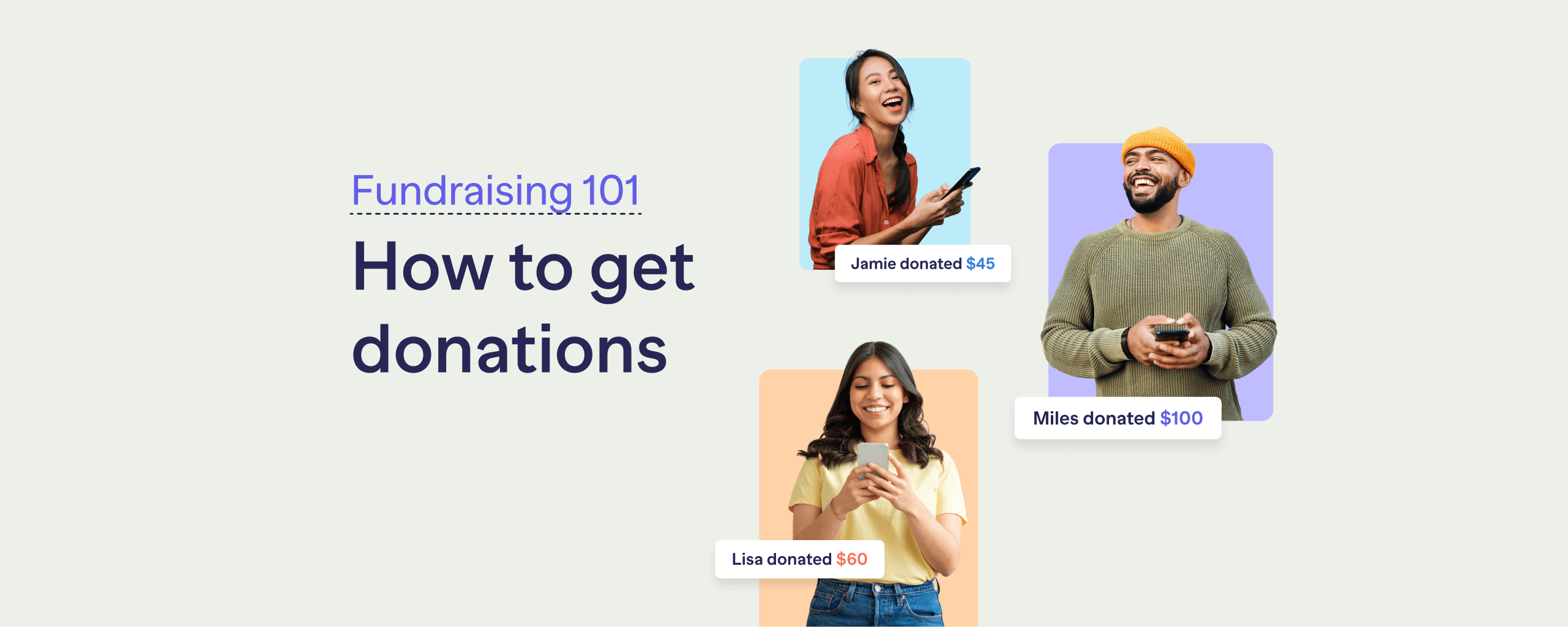
Fundraising 101: How to get donations
New to fundraising or looking for fresh ideas? This blog covers the basics, shares innovative fundraising ideas, and offers tips on engaging donors to boost your success. Dive in and...
Read More
How to Run an Online 50/50 Raffle: The Definitive Guide
A typical charity online 50/50 Raffle encourages donors to purchase entries for a chance to win a cash prize. While prize Raffles are crowd-pleasers and fundraisers, they can come with a...
Read More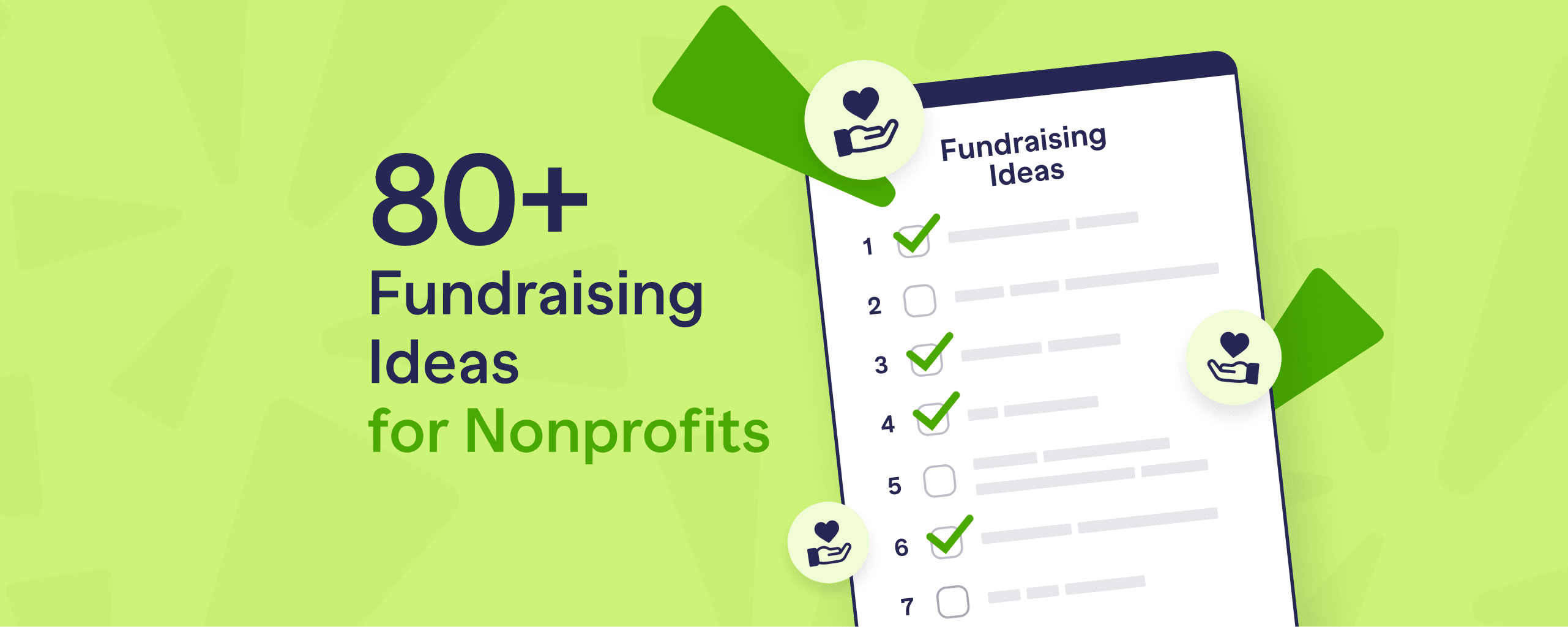
84 Fundraising Ideas for Nonprofits
Fundraising is the lifeblood of philanthropic organizations. More than half of nonprofit revenue in the United States comes from fees and sales, according to stats. That means that if you’re...
Read More